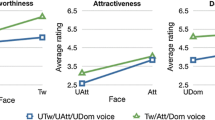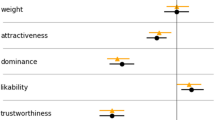Abstract
We examined personality impressions on five NEO subscales (Costa & McCrae, 1985) as a function of senders' vocal and physical attractiveness. There were four major findings: (a) both vocal and physical attractiveness produced more favorable ratings, and these effects were more pronounced in a single channel (voice only or face only, respectively) than in a multiple channel (voice plus face); (b) the influence of attractiveness, both vocal and physical, was moderated by subscale—the effect of vocal attractiveness was most pronounced for Neuroticism and nonexistent for Agreeableness; the effect of physical attractiveness was most pronounced for Extraversion and nonexistent for Conscientiousness; (c) a vocal attractiveness × physical attractiveness interaction indicated that effects of the two stereotypes were particularly strong for senders who were attractive on both channels; (d) the effects of attractiveness, both vocal and physical, diminished when judges were familiar with the target persons.
Similar content being viewed by others
References
Costa, P.T., Jr., & McCrae, R.R. (1980). Still stable after all these years: Personality as a key to some issues in adulthood and old age. In P.B. Baltes & O.G. Brim, Jr. (Eds.),Life span development and behavior (Vol. 3, pp. 65–102). New York: Academic Press.
Costa, P.T., Jr., & McCrae, R.R. (1985).The NEO Personality Inventory Manual. Odessa, FL: Psychological Assessment Resources.
Costa, P.T., Jr., & McCrae, R.R. (1988). From catalog to classification: Murray's needs and the five-factor model.Journal of Personality and Social Psychology, 55, 258–265.
McCrae, R.R. (1982). Consensual validation of personality traits: Evidence from self-reports and ratings.Journal of Personality and Social Psychology, 43, 293–303.
McCrae, R.R., & Costa, P.T., Jr. (1983). Joint factors in self-reports and ratings: Neuroticism, extraversion, and openness to experience.Personality and Individual Differences, 4, 245–255.
McCrae, R.R., & Costa, P.T., Jr. (1985a). Openness to experience. In R. Hogan & W.H. Jones (Eds.),Perspectives in personality: Theory, measurement, and interpersonal dynamics (Vol. 1). Greenwich, CT: JAI Press.
McCrae, R.R., & Costa, P.T., Jr. (1985b). Updating Norman's “adequate taxonomy”: Intelligence and personality dimensions in natural language and in questionnaires.Journal of Personality and Social Psychology, 49, 710–721.
McCrae, R.R., & Costa, P.T., Jr. (1987). Validation of the five-factor model of personality across instruments and observers.Journal of Personality and Social Psychology, 52, 81–90.
Norman, W.T. (1963). Toward an adequate taxonomy of personality attributes: Replicated factor structure in peer nomination personality ratings.Journal of Abnormal and Social Psychology, 66, 574–583.
Rosenthal, R., & Rosnow, R.L. (1984).Essentials of behavioral research: Methods and data analysis. New York: McGraw-Hill.
Rosenthal, R., & Rubin, D.B. (1982). A single, general purpose display of magnitude of experimental effect.Journal of Educational Psychology, 74, 166–169.
Tupes, E.C., & Christal, R.E. (1961). Recurrent personality factors based on trait ratings.USAF ASD Technical Report (No. 61–97).
Walker, H.M., & Lev, J. (1953).Statistical inference. New York: Holt, Rinehart, and Winston.
Zajonc, R.B. (1968). Attitudinal effects of mere exposure.Journal of Personality and Social Psychology, Monograph Supplement, 9, 1–27.
Zuckerman, M., & Driver, R. (1989). What sounds beautiful is good: The vocal attractiveness stereotype.Journal of Nonverbal Behavior, 13, 67–82.
Author information
Authors and Affiliations
Additional information
This research was supported in part by National Institute of Mental Health Grant RO1 MH 40498.
Rights and permissions
About this article
Cite this article
Zuckerman, M., Hodgins, H. & Miyake, K. The vocal attractiveness stereotype: Replication and elaboration. J Nonverbal Behav 14, 97–112 (1990). https://doi.org/10.1007/BF01670437
Issue Date:
DOI: https://doi.org/10.1007/BF01670437




